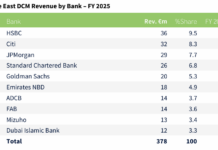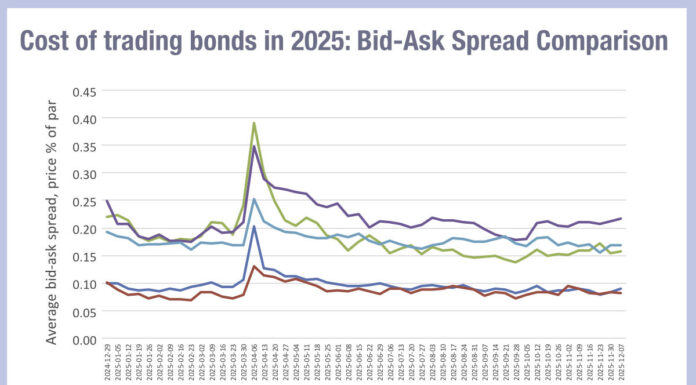Interoperability is not a competitive issue; clients will build it if platforms do not supply it.
There is not a consensus on who should make the bond issuance process more efficient. Everyone agrees it needs to improve. Banks have historically sent a “mess” of information about new bonds hitting the market to investment managers’ trading desks, who then have to sort out that mess.
Currently Bloomberg’s tools are most used, via its messaging and IB chat, allowing unstructured communication between the buy- and sell-side.
In the structured communication space, Investor Access (formerly Ipreo), owned by S&P, and rival DirectBooks, are leading the way as new platforms to standardise information exchange. DirectBooks appears to be dominant in the US market while Investor Access, which partners with Bloomberg has the lead in Europe and APAC, according to sources. Many other firms, including Liquidnet and Tradeweb, have also entered the fray.
“I’m building our primary market function, a cloud-based app, on DirectBooks,” says the head of US trading at a major buy-side firm. “I might have to go through the Ipreo platform to get European and Asian coverage in future, but I’m currently getting this developed in the US, pulling information on new issues from Bloomberg and DirectBooks as well. We have proprietary databases where we maintain our own information for credit ratings, opinions on ESG scores, aggregated using internal and external data, to give the PMs and analysts a ground floor presentation of new issue data.”
Working out which platform is most successful on a quantitative basis is difficult due to a lack of released data.
Investor Access reports 65 sell-side users and 629 buy-side users, while DirectBooks reports having 34 sell-side users and 400 buy-side users. Platforms typically do not provide information on activity, such as how many orders they communicate. Measuring the process improvements they deliver to users is also challenging.

Matt York, head of buy-side product strategy at Bloomberg, says there are ways to determine the efficiency gains that users can achieve through the employment of primary market tools.
“The simplest measure to use is, how many times does the trader actually have to touch an order?” he says. “Primary issuance has always been a pain, because you’re trying to elicit lots of interest internally around the firm, and aggregate it into one order. That means the trader has a million and one touch points, while constantly keeping track of who wanted an allocation, and the level at which they wanted it. That process has always been very, messy and cumbersome.”
Reducing these is fully achievable, he notes and other platforms also strive to tackle this issue.

“The overall goal of DirectBooks was to automate and standardise (OMS) primary issuance workflows and to eliminate most, if not all of the noise of multiple communications that are substantively the same,” says Rich Kerschner, CEO of DirectBooks. “From a buy-side perspective, not getting five versions of the same or conflicting details for the same deal information is a huge win. The ability to automate processes and workflows including order interest and allocation messages through DirectBooks has also been a big improvement for the entire industry.”
York says, “A buy-side firm, aggregating interest from different portfolio managers, through to a trader and then posting those out can see a 75% reduction, on average, through an OMS. But the challenge is, people do need to change their process to be able to get that.”
Where are we on standardisation of issuance?
If buy-side firms can get standardised information on a deal from the sell-side – whose clients are bond issuers – then the buy side can compile a single picture of what is on offer, and portfolio managers can work out if they want in on the deal, and at what level. The lack of standardised communication is what causes the ‘mess’ so frequently described today.
“Competition is good,” says Carl James, global head of Fixed Income – Global Markets Group, at S&P Global Market Intelligence. “Yet the rails that competition travels along need standardisation. The electronification of the equity market decades ago led to fragmentation, but the FIX protocol came along [standardising the way order messages were communicated] and set the rails for trading on any given platform. We’re pretty close to doing that in primary markets.”
Negotiating and providing guidance to banks on standardisation has been attempted on many occasions. In 2017 the FICC Markets Standards Board (FMSB) did so to enhance the fairness and effectiveness of the new issue process for all participants, with the backing of many issuers.
The proposals in the standard included that lead banks should make their allocation policies available to issuers and all market participants, with the issuer’s preferences being taken into account when deciding the allocation policy for a specific/individual deal; that lead banks should disclose publicly their general policy for how they select investors for market soundings and roadshows with a strategy on book disclosure frequency with the issuer; while investors should only submit clear orders which are a true reflection of their demand.
In 2020, The Credit Roundtable, a US buy-side lobby group for bondholder protection, issued the ‘Investment Grade Primary Best Practices Framework’ designed to improve bond issuance. These included: consistency of preliminary deal terms disclosed by the active bookrunners; terms including ‘Expected’ ratings provided with stated/disclosed ‘Initial Price Talk’ and details including actual maturity date of bond; indication of initial size of deal; actual ‘Cusip’ codes for bond(s); a full list of underwriting participants of the deal before the order book ‘Subject’ with a reasonable settlement period; and deals priced before 4:30 during normal UST market trading hours or risk pricing the next day.
In 2020 regulators voiced concerns that dealers may be preventing the development of standardised information by penalising investors who complain.
“Buy-side participants with whom we have spoken worry that if they complain about information availability, or back out of an offering after submitting an order, dealers will retaliate by giving a smaller allocation in a subsequent offering,” wrote the SEC in the 2020 Fiscal Year report for the Office of the Investor Advocate.
Having been provided with this detailed guidance by both issuers and buyers, none was formally adopted by sellers.
Dealers in the US market did form a consortium to back one technology platform – DirectBooks – which would compete with the existing platforms, Investor Access, then called Ipreo, and Bloomberg.
However, a platform can find it challenging to impose standards upon its users, as Kerschner notes.
“We have built the DirectBooks platform to balance the need for rules in an automated, electronic process, while also allowing for enough flexibility, particularly in the initial stages of the primary issuance process, which can be a bit chaotic and messy,” he says. “Just because your users agree to rules of engagement on the platform doesn’t mean the workflow occurring outside of the platform is going to immediately bend to that.”
The rise of multiple competing platforms also led to concerns on the buy side that standardisation would be impossible, thwarted by the development of rival standards.

The FIGI leaf
As a counterpoint, James’ confidence that standardisation is close stems from the willingness of many businesses to provide interoperability between their systems.
Nick Hall, head of fixed income primary markets, at Bloomberg, says, “The majority of buy side firms out there don’t want to fit another platform onto their desktop, they were waiting for connectivity from the OMS and EMS all the way to the bookbuilding systems. We launched a connection from AIM and TSOX to Investor Access three months ago, and that’s the first time that anyone has ever connected an OEMS platform.”
Olivier Dermaux, executive director for Fixed Income Strategy – Global Markets Group, at S&P Global Market Intelligence concurs, noting, “Everything is evolving away from providing the interface to issuance, our integration with OMSs like Bloomberg and Charles River provide an interface to place orders and receive information.”
It is also possible for users to develop their own interoperability tools if platforms do not natively develop interoperability. Low code technology providers such as Genesis, are building tools that pull together data from the platforms and combine them with other tools buy-side clients take, which includes processing deal data from email and Bloomberg chat into the application, in a single workflow.

“Why not give traders the power to see everything in one place?” says Rahul Kambli, product manager for Primary Bond Issuance at Genesis. “Our solution allows them to bring in analytics systems, to use a chat function such a Symphony or Teams to discuss which of today’s deals fits their ethos best. That way this highly skilled, highly trained and highly paid user is enriching the new issue process with internal parties, and bringing them into conversations by highlighting these deals to them. Once they’ve seen what’s going on, they can make decisions. We also have support for OMSs to create orders, perform compliance checks and send them across to the syndicate.”
A greater challenge than interfaces, Dermaux says, is overcoming the absence of the bank-issued international securities identification number (ISIN), a 12-digit code that assists in identifying securities at the start of the bond issue.
“The challenge is that they cannot always have the ISIN at inception of a bond and if they don’t have an identifier for a bond how do they create a security to trade or move internally?” he asks. “You hope the banks issue the ISIN fast.”

Investor Access, Bloomberg and Liquidnet all use the Bloomberg administrated Financial Instrument Global Identifier (FIGI) as a standard to get past this problem. Once that code is issued, a firm has a model for it that allows the instrument to be tracked and traded. This standard reference allows the security to be moved between different systems easily, creating interoperability. For the user, the FIGI covers the gaps between systems, allowing the user experience to be relatively seamless.
“ISIN dissemination normally takes around two hours, a window in which you’ve got the FIGI universally available,” explains York. ”It’s going to be a very good thing for the for the new issue market.”
Smooth allocator
Competing on functionality rather than operability barriers puts the choice of how to trade in the hands of the user, says James.
Competing on functionality rather than operability barriers puts the choice of how to trade in the hands of the user, says James.

“If you want to watch a film you don’t care if it’s Amazon Prime, or Netflix, you just want to watch the film,” he says. “Our solutions leverage predictive analysis and other essential tools, leading to better functionality. But if a trader wants to buy a bond they should be able to get that access whether it’s from us, or another firm, without a barrier.”
With buy-side firms able to use their OMSs or build their own tools to aggregate primary market workflows, optimism for greater platform adoption, thanks to that interoperabilityis potentially high. Estimates range between high single digit to about 10% of total primary order flow being electronically processed via platforms, with some estimating a share of up to 40% in their specific fields, and that could increase substantially in 2024.
“There are still issues,” notes one observer. “Feedback is that some platforms are still not quick enough, the process of going from the priced issue to allocate issue is still taking too long, considering its electronified. The risk we have there is if someone said it was actually easier for to communicate with syndicate banks via a chat message or an email than going through the platform, then that’s going to be a risk for adoption.”
“I would be reluctant to go down the path of connecting to a different API,” says the buy-side head of US trading. “I already need two API’s for error handling to managing duplicate information if it’s appears in Bloomberg and also from DirectBooks. I’m a big advocate here in the US for DirectBooks and making sure that dealers price, give guidance and launch in a timely fashion. I’m trying to get them to the point where DirectBooks becomes as timely as Bloomberg.”
©Markets Media Europe 2023
©Markets Media Europe 2025












